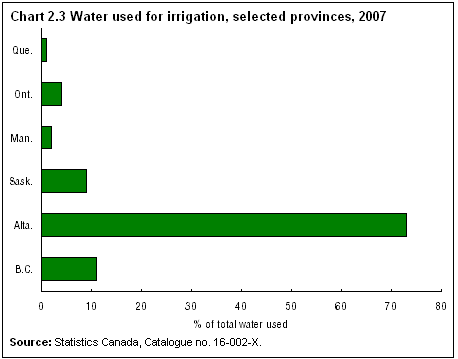Watering the dry spots
Archived Content
Information identified as archived is provided for reference, research or recordkeeping purposes. It is not subject to the Government of Canada Web Standards and has not been altered or updated since it was archived. Please "contact us" to request a format other than those available.
Related information
Canada is not particularly arid. The 2006 Census of Agriculture reported that 7% of farms were using irrigation. However, irrigation is a must in a few areas.
Some of Canada's driest agricultural areas are in central and southeastern British Columbia, southern Alberta, and southwestern Saskatchewan. Alberta farms use more water by volume, accounting for 73% of all water used for irrigation in 2007; British Columbia and Saskatchewan combined used another 20%.
The amount of water used on a farm depends on the crop and the region. Grain and oilseed farms in the Prairies typically have a larger average acreage than the orchards of British Columbia or farms in Ontario and Quebec.
Among farms using irrigation, more than 70% of prairie farms and 53% of farms in British Columbia used off-farm water, mostly from provincial sources.
For example, most irrigators in Alberta receive allocations of water from provincial irrigation districts. Water from off the farm must be transported—tankers, canals or aqueducts bring water from suitable sources.
- Date modified:

